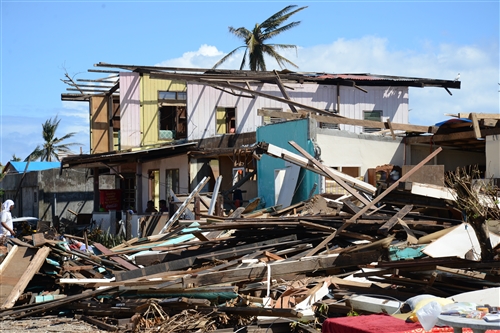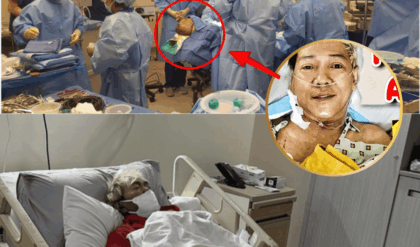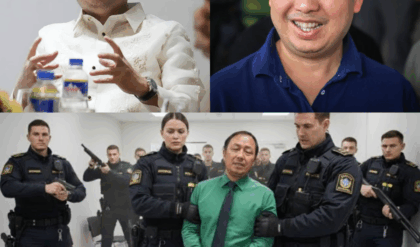🙏 “God, Please Keep Us Safe”: Davao Oriental Shaken by a 7.6-Magnitude Earthquake — Fear, Faith, and the Nation’s Call to Prayer
By [Your Tabloid Desk]
On the morning of Friday, October 10, 2025, at precisely 9:43 a.m., the earth beneath Davao Oriental groaned, shifted, and unleashed one of the most powerful quakes in recent Philippine memory. Measuring 7.6 on the Richter scale, the tremor rattled homes, schools, and hospitals. It sent residents spilling into the streets, eyes wide with terror, clutching rosaries and cellphones, unsure if they would live to see another hour.
The Philippines is no stranger to calamities, but this one struck differently. For the thousands who felt the ground heave violently beneath their feet, it was more than an earthquake. It was a reminder of life’s fragility, of how quickly routine can turn into chaos.
As aftershocks rippled through the region, the cry of the people rose not only in fear but in faith. Across social media, radio, and church loudspeakers, one plea echoed again and again:
“God, please keep us safe.”

⚡ The Moment the Earth Shook
Residents of Mati City, the provincial capital, recall the instant with chilling clarity.
At first, a low rumble, like distant thunder rolling across the sea. Then, in seconds, the rumble swelled into a roar, the ground buckled, and buildings shuddered as if they were toys in the hands of a giant.
Ceilings cracked.
Glass windows shattered.
Motorcycles toppled.
Children screamed.
“I thought it was the end of the world,” said Erlinda, a 62-year-old grandmother who had been cooking breakfast when her house shook violently. “I grabbed my grandchild and we ran outside, barefoot, not even thinking about the boiling pot on the stove. All I could think was, Lord, save us.”
🏫 Panic in Schools and Offices
At the time of the quake, thousands of students were in classrooms. Videos posted online showed pupils crouching under desks as teachers shouted for calm. Some schools had practiced earthquake drills—but nothing prepared them for the sheer violence of a 7.6 tremor.
In government offices, stacks of paperwork flew from cabinets. Employees huddled under tables before rushing out to open grounds. At the Davao Oriental Provincial Capitol, employees were seen crying as they evacuated the building, still shaking minutes after the tremor subsided.
🏥 Hospitals and Emergency Response
Hospitals faced perhaps the greatest chaos. Patients on IV drips were wheeled outside as staff shouted instructions over blaring alarms. Families of patients rushed into parking lots, fearing aftershocks.
At least one wing of the Davao Oriental Regional Medical Center sustained cracks, prompting a partial evacuation. Doctors treated patients outdoors, shaded only by tarpaulins hastily erected. Nurses were seen clutching both medical supplies and rosaries, praying as they worked.
“It was chaos,” admitted one ER doctor. “But we could not stop. We had to keep saving lives—even if the ground kept shaking.”
🌊 Tsunami Fears
Minutes after the quake, rumors spread rapidly: could a tsunami be next?
The epicenter was offshore, and the Philippine Institute of Volcanology and Seismology (PHIVOLCS) initially issued a tsunami warning. Sirens blared in some coastal towns, and people living near the shoreline sprinted inland, clutching bags, children, and whatever valuables they could grab.
By afternoon, the warning was lifted. But the panic of those first hours will not soon be forgotten. For many, the fear of the sea rising was as terrifying as the quake itself.
📲 Social Media Erupts
Within minutes, hashtags like #PrayForDavaoOriental, #EarthquakePH, and #OratioImperata surged across X (formerly Twitter), TikTok, and Facebook.
Videos captured:
People fleeing buildings in downtown Mati.
Teachers herding students to evacuation areas.
Long lines of patients on stretchers outside hospitals.
The online world became both a lifeline and a mirror of fear. Messages of solidarity flooded in:
“Stay safe, Davao Oriental. We are praying for you.”
“Hold on, Mindanao. Kapit lang.”
“God, protect the Philippines.”
🙏 The Oratio Imperata: A Nation Turns to Prayer

By midday, local churches began broadcasting the Oratio Imperata, the traditional Catholic prayer invoked during times of disaster.
Priests urged people to join in, whether in chapels, streets, or evacuation centers. Families clasped hands, reciting the words together:
“Deliver us, O Lord, from the fury of earthquakes. Keep us safe from harm and danger. Strengthen our faith in these times of trial.”
It was a powerful, unifying moment. Even in panic, even in fear, the people of Davao Oriental turned to faith as their anchor.
💬 Survivor Voices
“The ground moved like waves. I couldn’t even stand.” — Jomar, fisherman
“I was holding a patient’s hand as the walls cracked. We both prayed aloud.” — Leah, nurse
“We lost our home in seconds. But we still have life, and for that we thank God.” — Crisanto, evacuee
These testimonies—raw, emotional, desperate—flooded both mainstream and social media. They painted a vivid portrait of survival amid chaos.
📰 Media Frenzy
National and international outlets quickly seized on the story.
CNN Philippines declared: “Davao Oriental Rocked by 7.6 Quake: Scenes of Panic and Prayer.”
ABS-CBN News ran with: “Oratio Imperata Echoes as Thousands Evacuate in Mindanao Quake.”
The BBC’s Asia desk warned: “Philippines Faces Quake Trauma: Fear of Aftershocks Looms.”
The disaster had, once again, thrust the Philippines into global headlines—not for its beauty, but for its vulnerability.
💔 Trauma and Aftershocks
As dusk fell on Friday, aftershocks continued to rattle nerves. Some measured as strong as 5.0. Each tremor sent fresh waves of panic through evacuation centers.
Psychologists warned of widespread trauma, particularly among children who screamed at even the faintest rumble.
“It will take weeks, even months, for people to feel safe again,” one mental health professional noted.
🏚️ Damage and Loss
Preliminary reports revealed dozens of houses damaged, some reduced to rubble. Schools bore cracks, roads split open, and power outages left parts of the province in darkness.
The full scale of destruction remained unclear as night fell. But one thing was certain: thousands were displaced, fearful, and uncertain about the future.
🌏 Global Response
Aid pledges began to pour in from NGOs and international partners. Filipino communities abroad launched donation drives. The world was watching, and praying, with Davao Oriental.
✨ Resilience Amid Ruins
And yet, amid the chaos, stories of courage and kindness emerged. Volunteers distributed food and water. Neighbors shared tarpaulins to cover families sleeping outdoors. Priests and pastors led prayer vigils in parking lots.
The quake had shaken buildings, but it could not shake the Filipino spirit.
🔮 What Comes Next?
Seismologists warned of aftershocks. Engineers began inspecting bridges and public facilities. Government officials promised aid.
But for the people of Davao Oriental, the greatest question remained unanswered:
“Will we ever feel safe again?”
For now, their answer lies not in science alone but in prayer, resilience, and the hope that God heard their plea.
🌟 Conclusion: Fear, Faith, and Fragility
The 7.6-magnitude earthquake of October 10, 2025 will be remembered not just for its power but for its human stories: the grandmother clutching her grandchild, the nurse praying over her patient, the families chanting the Oratio Imperata in trembling voices.
In those moments, the people of Davao Oriental were united in one cry:
“God, please keep us safe.”
It was a cry of fear. A cry of faith. And a cry that continues as the earth rumbles, the aftershocks linger, and a province prays for calm.





